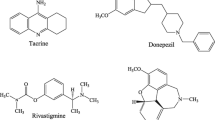Abstract
Crystals of this calabash curare alkaloid, space groupP21; havea=12.695(4), Å,b=7.424(2) Å,c=21.762(6) Å,β=98.03(5)°,Z=2,F(000)=884. The structure was solved by direct methods and refined by least squares toR=0.10. The alkaloid cation, with two-fold molecular symmetry, has a highly fused ring system and is structurally rigid. This determination provides accurate stereochemical parameters for those atoms and groups (N+ centers, aromatic rings, and hydrogen bond acceptors) postulated by various theories as involved in binding to the acetylcholine receptor. In the crystal, layers of alkaloid cations parallel to thebc plane alternate with layers containing two Cl− ions and eight water molecules distributed almost randomly over ten sites. Electrostatic attractions between N+ and Cl− bind the alternating layers together. Each one of the ten sites is, on average, 4.60 Å from one or two N+, allowing the two Cl− ions to be disordered. Binding interactions within the alkaloid layers are solely van der Waals attractions. Within each H2O/C1− layer there is a complex hydrogen bond system, including four infinite spirals parallel to theb axis, with an average bonding distance of 2.94 Å. There are no hydrogen bonds between layers. The possible relevance to the activity of the alkaloid of its ability to organize large amounts of water is discussed.
Similar content being viewed by others
References
Battersby, A. R., and Hodson, H. F. (1960)J. Chem. Soc., 736–741.
Beers, W. H., and Reich, E. (1970)Nature (London) 228, 917–922.
Clark, J. R. (1963)Rev. Pure Appl. Chem. (Aust.) 13, 50–90.
Codding, P. W., and James, M. N. G. (1973)Acta Cryst. B 29, 935–942.
Cromer, D. T., and Mann, J. B. (1968)Acta Cryst. A 24, 321–324.
Everett, A. J., Lowe, A., and Wilkinson, S. (1970)Chem. Commun., 1020–1021.
Feil, D., and Jeffrey, G. A. (1961)J. Chem. Phys. 35, 1863–1873.
Hamilton, W. C., and Ibers, J. A. (1968)Hydrogen Bonding in Solids (W. A. Benjamin, New York), pp. 190, 220–221.
Hider, R. C. (1979) InAdvances in Cytopharmacology, B. Ceccarelli and F. Clementi, eds., Vol. 3 (Raven Press, New York), p. 149.
Hider, R. C., and Dufton, M. J. (1979) InNatural Toxins, D. Eaker and T. Wadstrom, eds. (Pergamon Press, New York), pp. 515–522.
Jeffrey, G. A. (1969)Acc. Chem. Res. 2, 344–352.
Jones, N. D., and Nowacki, W. (1972)Chem. Commun., 805.
Low, B. W. (1979) InHandbook of Experimental Pharmacology, C.-Y. Lee, ed., Vol. 52 (Springer-Verlag, Berlin), pp. 213–257.
Low, B. W., Preston, H. S., Sato, A., Rosen, L. S., Searl, J. E., Rudko, A. D., and Richardson, J. S. (1976)Proc. Natl. Acad. Sci. U.S.A. 73, 2991–2994.
Main, P., Hull, S. E., Lessinger, L., Germain, G., Declercq, J.-P., and Woolfson, M. M. (1978)Multan 78. A System of Computer Programs for the Automatic Solution of Crystal Structures from X-ray Diffraction Data (Universities of York, England, and Louvain, Belgium).
Martin-Smith, M. (1971) InDrug Design, Vol. II, E. J. Ariens, ed. (Academic Press, New York), pp. 503, 513–514.
McPhail, A. T., and Sim, G. A. (1965)J. Chem. Soc., 1663–1675.
Menez, A., Boulain, J.-C., Faure, G., Couderc, J., Liacopoulous, P., Tamiya, N., and Fromageot, P. (1982)Toxicon 20, 95–103.
Miller, S. L. (1961)Proc. Natl. Acad. Sci. U.S.A. 47, 1515–1524.
North, A. C. T., Phillips, D. C., and Mathews, F. S. (1968)Acta Cryst. A 24, 351–359.
Pauling, L. (1961)Science 134, 15–21.
Reynolds, C. D., Palmer, R. A., Gorinsky, B. A., and Gorinsky, C. (1975)Biochim. Biophys. Acta 404, 341–344.
Scanlon, W. J., and Eisenberg, D. (1976)Biochem. Biophys. Res. Commun. 72, 1285–1291.
Sheldrick, G. M. (1976)Shelx-76. A Program for Crystal Structure Determination (University of Cambridge, England).
Sobell, H. M., Sakore, T. D., Tavale, S. S., Canepa, F. G., Pauling, P., and Petcher, T. J. (1972)Proc. Natl. Acad. Sci. U.S.A. 69, 2212–2215.
Stewart, R. F., Davidson, E. R., and Simpson, W. T. (1965)J. Chem. Phys. 42, 3175–3187.
Still, W. C. (1983) Chemistry Department, Columbia University, private communication.
Triggle, D. J. (1971)Neurotransmitter-Receptor Interaction (Academic Press, New York), p. 355.
Tsernoglou, D., and Petsko, G. (1976)FEES Lett. 68, 1–4.
Wyckoff, R. W. G. (1931)The Structure of Crystals, 2nd edn., American Chemical Society Monograph Series (The Chemical Catalog Company, New York), pp. 365–366.
Author information
Authors and Affiliations
Rights and permissions
About this article
Cite this article
Bourne, P.E., Ginell, S.L., Low, B.W. et al. Structure of a potent neuromuscular blocking agent: Caracurine-II dimethochloride octahydrate, [C40H44N4O2]2+·2CI−·8H2O. Journal of Crystallographic and Spectroscopic Research 15, 453–471 (1985). https://doi.org/10.1007/BF01171049
Received:
Issue Date:
DOI: https://doi.org/10.1007/BF01171049




